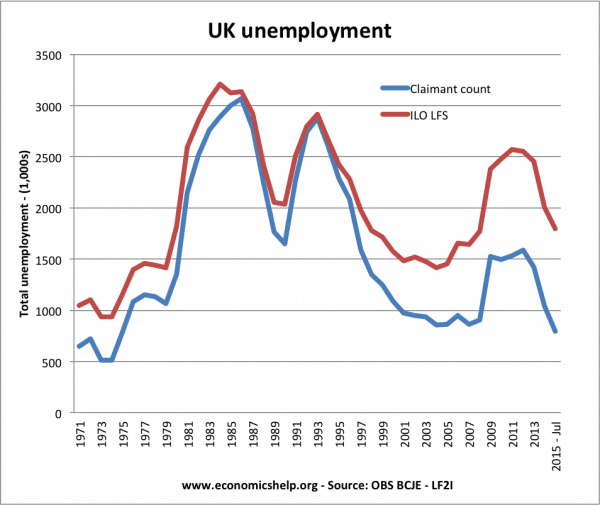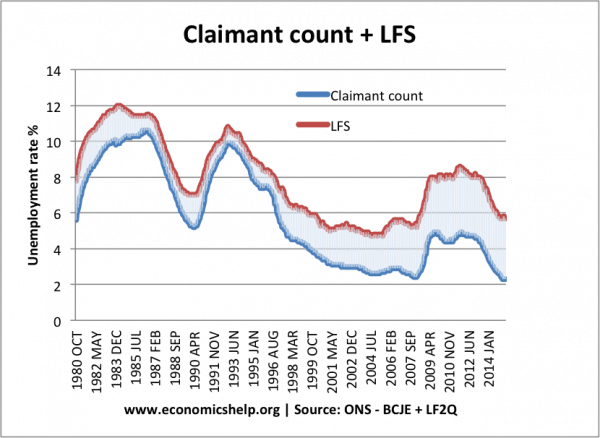In the UK there are two main measures of unemployment –
- The claimant count (number receiving unemployment benefits)
- ILO – Labour Force Survey (A survey which asks – are you unemployed and actively seeking work?)
Graph showing unemployment levels

In recent years, the gap between the labour force survey and the claimant count method has increased. This reflects the fact the unemployed may not be eligible for benefits.
1. Claimant count method
This method calculates unemployment by measuring the number of people receiving benefits (Jobseekers allowance)
There are two types of JSA:
- Contribution based JSA – if you have paid two years of NI contributions, you can be paid JSA whatever you income and savings. This can be paid for 6 months.
- Income Based JSA – This is paid to those on low incomes and with low savings. If you have not made sufficient contributions, you will still be eligible for this as long as your income is not too high.
Issues with claimant count
- The government has often changed the criteria (30 times since 1979) for those who are eligible for benefits, usually this has been to reduce the claimant count. This makes it difficult to compare over time.
- The claimant count excludes:
- People over pension age, who will typically claim pensions rather than JSA
- People under 18, (with a few exceptions)
- People in full time education, who may still be classed as unemployed.
- People not eligible for contribution based JSA. To claim the contributions based JSA they need to have paid at least two years of NI contributions.
- Also, their level of savings or their partner’s income may be too high to be eligible.
- Any one on a government training schemes,
- Some people may not claim JSA even when they are eligible to.
- Married women looking to return to work
- Those looking for part time work and not full time work
- Some people may claim benefits whilst still working in the “black market” i.e. claim JSA fraudulently.
- Some people may be able to work up to 16 hours a week and still legally claim JSA
- Some people may be eligible for JSA but actually classed as inactive rather than unemployed. For example, if you do insufficient searching for job, you may be classed as economically inactive.
More: info on claimant count
2. Labour force survey method
This is compiled using the ILO criteria of comparing unemployment. The criteria involve:
- Are people without a job, want a job, have actively sought work in the last four weeks, and are able to start work within the next two weeks; or
- are out of work, have found a job and are waiting to start it in the next two weeks
The Labour Force survey asks 60,000 people whether they are unemployed and whether they are looking for a job.
- It includes some people not eligible for JSA.
- It is good for international comparisons.
However some problems of labour force survey
- It could be subject to sampling errors and may not be truly representative
- Difficult to decide whether somebody is sick or actively seeking work
Difference between claimant count and JSA

The gap between the claimant count and JSA has increased since the 1990s because it has become harder to receive job-seekers allowance.
Difficulties with measuring unemployment
- Under-employment. People may be officially classed as employed. However, they may be working fewer hours than they would like. For example, they may have a part-time job, but want a full-time jobs.
- Inactivity rates/Leaving job market. Another issue is that the long-term unemployed may become discouraged and leave the labour market completely. For example, areas of high structural unemployment, tend to have higher levels of people claiming long-term sickness and disability allowance. In effect they are not working, but they are classed as economically inactive rather than unemployed. If unemployment falls, but inactivity increases, then this is a sign the fall in unemployment may be misleading.
Other options useful for understanding the labour market
- Measure employment rates. Look at total number employed and % of working age in employment.
- Economic activity rates. % economically active
Related
- What is the real rate of unemployment in UK?
- UK Unemployment rate
- Labour Market Statistics at Statistics.gov.uk
- JSA at Direct Gov
